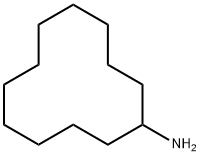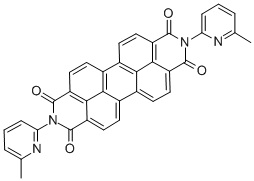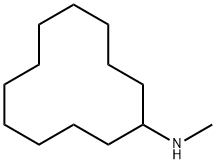CYCLODODECYLAMINE
- CAS NO.:1502-03-0
- Empirical Formula: C12H25N
- Molecular Weight: 183.33
- MDL number: MFCD00003718
- EINECS: 216-118-2
- SAFETY DATA SHEET (SDS)
- Update Date: 2024-12-18 14:15:32

What is CYCLODODECYLAMINE?
Chemical properties
CLEAR SLIGHTLY YELLOW LIQUID AFTER MELTING
Production Methods
Cyclododecylamine is produced by reduction of cyclododecanone oxime with sodium and an alcohol, by catalytic reduction of nitrocyclododecane with hydrogen, by Ritter reaction of cyclododecene with hydrocyanic acid, or by hydrogenation of cyclododecanone under amination conditions. The reaction of cyclododecylamine with propylene oxide leads to a product that can undergo cyclization to give the fungicide Dodemorph (BASF). The compound behaves chemically as a primary amine.
Purification Methods
It can be purified via the hydrochloride salt m 274-275o (from EtOH) or the picrate m 232-234o, and the free base is distilled preferably at water-pump vacuum [Prelog et al. Helv Chim Acta 33 365 1950].
Properties of CYCLODODECYLAMINE
| Melting point: | 27-29 °C(lit.) |
| Boiling point: | 122-124 °C7 mm Hg(lit.) |
| Density | 0.9093 (rough estimate) |
| refractive index | 1.487-1.489 |
| Flash point: | 250 °F |
| storage temp. | Keep in dark place,Inert atmosphere,Room temperature |
| pka | 10.98±0.20(Predicted) |
| CAS DataBase Reference | 1502-03-0(CAS DataBase Reference) |
| EPA Substance Registry System | Cyclododecanamine (1502-03-0) |
Safety information for CYCLODODECYLAMINE
| Signal word | Warning |
| Pictogram(s) |
 Exclamation Mark Irritant GHS07 |
| GHS Hazard Statements |
H315:Skin corrosion/irritation H319:Serious eye damage/eye irritation H335:Specific target organ toxicity, single exposure;Respiratory tract irritation |
| Precautionary Statement Codes |
P261:Avoid breathing dust/fume/gas/mist/vapours/spray. P264:Wash hands thoroughly after handling. P264:Wash skin thouroughly after handling. P280:Wear protective gloves/protective clothing/eye protection/face protection. P305+P351+P338:IF IN EYES: Rinse cautiously with water for several minutes. Remove contact lenses, if present and easy to do. Continuerinsing. |
Computed Descriptors for CYCLODODECYLAMINE
New Products
Tert-butyl bis(2-chloroethyl)carbamate (S)-3-Aminobutanenitrile hydrochloride N-Boc-D-alaninol N-BOC-D/L-ALANINOL N-octanoyl benzotriazole 4-Hydrazinobenzoic acid 3,4-Dibenzyloxybenzaldehyde Electrolytic Iron Powder 1,1’-CARBONYLDIIMIDAZOLE R-2-BENZYLOXY PROPIONIC ACID 4-HYDROXY BENZYL ALCOHOL 1,1’-CARBONYLDI (1,2-4 TRIAZOLE) S-2-CHLORO PROPIONIC ACID (2-Hydroxyphenyl)acetonitrile 4-Bromopyrazole 5-BROMO-2CYANO PYRIDINE 5,6-Dimethoxyindanone 5-broMo-2-chloro-N-cyclopentylpyriMidin-4-aMine 3-(Hydroxymethyl)benzoate N-Boc-2-chloroethylamine 1-Bromo-2-methoxy-3-nitrobenzene N-Methyl-3-cyclopenten-1-amine 2-Bromo-3-hydroxybenzaldehyde 1H-indazole-5-carboxamideRelated products of tetrahydrofuran








You may like
-
 7441-43-2 98%View Details
7441-43-2 98%View Details
7441-43-2 -
 1260741-78-3 6-Bromo-3-iodo-1-methyl-1H-indazole 98%View Details
1260741-78-3 6-Bromo-3-iodo-1-methyl-1H-indazole 98%View Details
1260741-78-3 -
 (3-Benzyloxypropyl)triphenyl phosphonium 98%View Details
(3-Benzyloxypropyl)triphenyl phosphonium 98%View Details
54314-85-1 -
 4-bromo-3,5-dimethylbenzenesulfonyl chloride 1581266-79-6 98%View Details
4-bromo-3,5-dimethylbenzenesulfonyl chloride 1581266-79-6 98%View Details
1581266-79-6 -
 2490430-37-8 98%View Details
2490430-37-8 98%View Details
2490430-37-8 -
 N-(5-Amino-2-methylphenyl)acetamide 5434-30-0 98%View Details
N-(5-Amino-2-methylphenyl)acetamide 5434-30-0 98%View Details
5434-30-0 -
 124371-59-1 98%View Details
124371-59-1 98%View Details
124371-59-1 -
 53857-52-2 98%View Details
53857-52-2 98%View Details
53857-52-2
Statement: All products displayed on this website are only used for non medical purposes such as industrial applications or scientific research, and cannot be used for clinical diagnosis or treatment of humans or animals. They are not medicinal or edible.